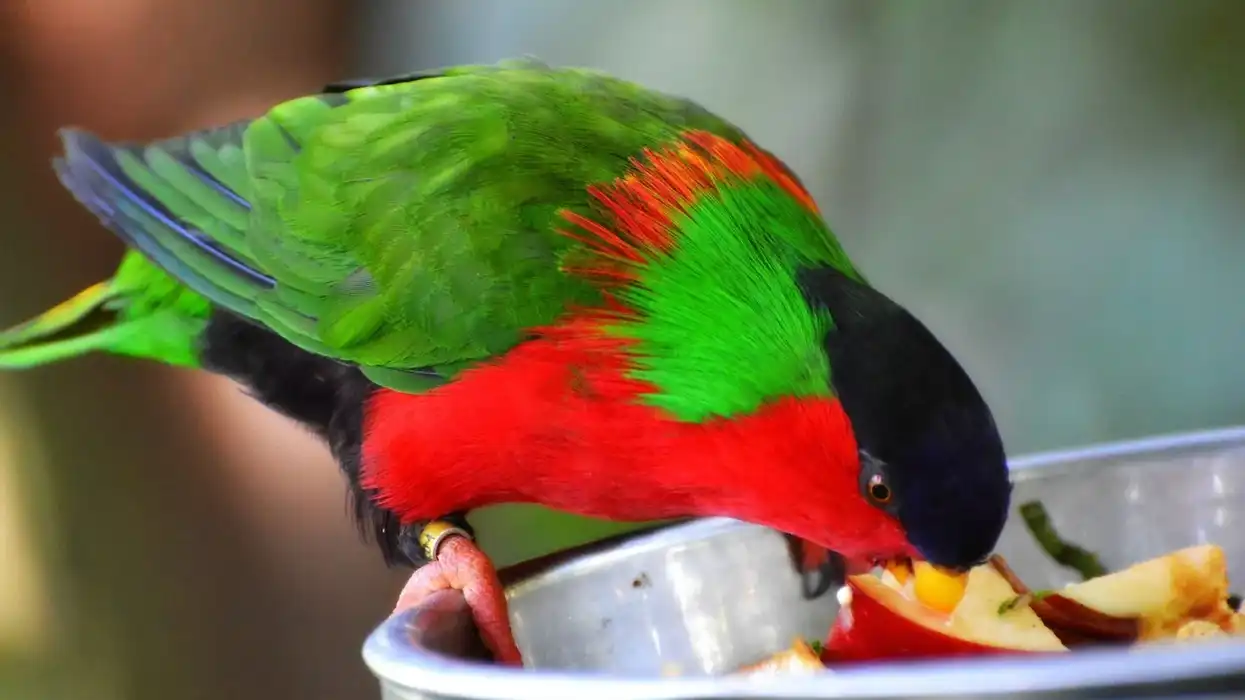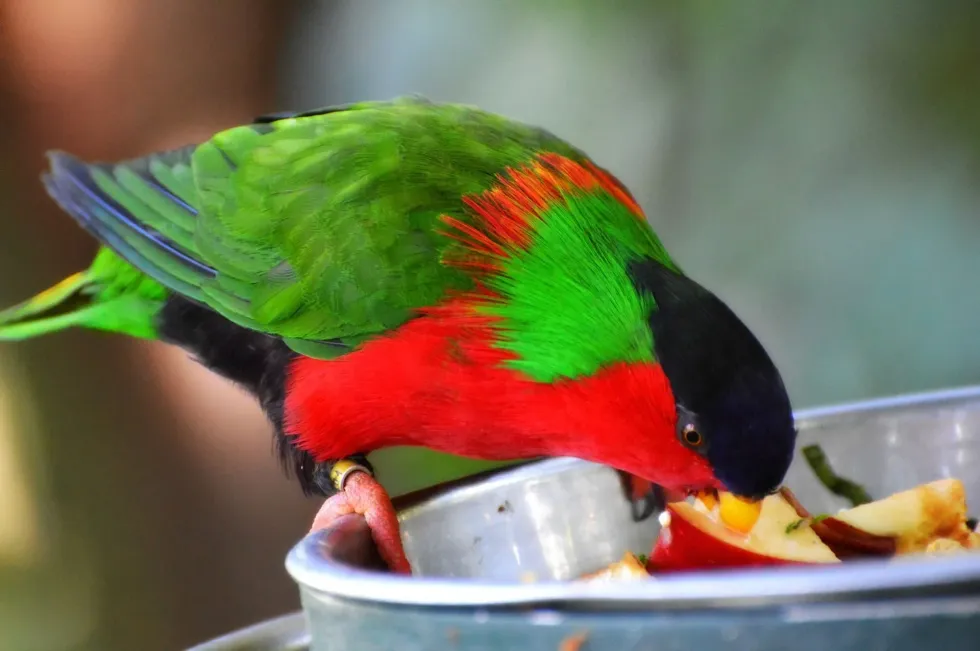The red lory scientific name is Eos bornea of order Psittaciformes, genus Eos, and family Psittacidae. It is a species of parrots native to the Molucca and other surrounding islands (Buru, Kai) of Indonesia. These birds can be divided into two subspecies namely the Buru red lory and Eos bornea bornea.
The red lory (Eos bornea) parrots are among the most commonly kept lory in captivity. This bright-colored bird species approximately weighs around 5.3-5.6 oz (150.2-158.7 g) and is about 12.2 in (31 cm) in size.
Although omnivores by nature, lories mainly consume fruit or nectar-based diet and are characterized by a specialized brush-like tongue which they use to pick pollen or collect nectar.
A strong orange beak helps these birds to crack open hard shells of nuts and seeds with ease. Even though these birds are marked as Least Concern, their population has been observed to be decreasing in the wild.
Keep reading to know more interesting red lory facts! Check out rook bird and umbrellabird to learn more about them.
Red Lory Bird Interesting Facts
What type of animal is a red lory bird?
The red lory (Eos bornea) is a small species of parrots. They are among the most commonly kept lory in captivity. The fascination is understandable because the lory, red in color with a tinge of blue, is irresistible for a pet bird enthusiast mainly due to its striking color combination and its playful personality.
What class of animal does a red lory bird belong to?
Red lories belong to the class Aves, just like the great potoo. These birds are strong fliers, often traveling great distances to search and forage for food.
How many red lory birds are there in the world?
The exact number of the red lory species has not been quantified but it is known that a red lory's life in the wild isn't quite lonesome. Overall, their distribution is well balanced out. However, their population has been decreasing due to exploitation.
Where does a red lory bird live?
The red lory range map is distributed in the surrounding islands of Indonesia and is primarily concentrated in the Maluku province. The distribution of both the subspecies includes Buru, Kai, Tayandu, and Banda Islands, among others
What is a red lory birds’ habitat?
Red lory parrots usually inhabit the tropical moist lowland forests and mangrove forests of Indonesia and adjoining islands. Their distribution includes the surrounding woodland, gardens, and coconut plantations of the islands.
Who does red lory bird live with?
Lories are social birds and are usually found in flocks, consisting of about 12-14 lories. However, they are not very tolerant of other bird species and can get aggressive when it comes to protecting their territories.
How long does a red lory bird live?
On average, the red lory lifespan ranges between 15-20 years. However, some is said to live past their thirties under proper care. Lory parrots, on the other hand, can live up to 30 years.
How do they reproduce?
Red lories mature early and are ready to breed by eight months of age. These birds usually lay two eggs at a time.
The incubation period is about 25 days long. Lories are known to make nests in their wild, natural habitat.
In captivity, similar arrangements need to be made inside the cage, either by building a natural or an artificial nest.
Although eggs are incubated by the mother and male lories do not play any role in incubation, they are quite possessive about both the mate and the offspring and can get highly territorial during the mating season. Red lory chicks start maturing by five months of age but stay with their parents until reaching full maturity (eight months).
What is their conservation status?
The red lory species of Indonesia has an abundant distribution in the wild and in captivity. The Buru red lory is the most common. The International Union For Conservation Of Nature or IUCN has listed the conservation status of this species as Least Concern.
Red Lory Bird Fun Facts
What does the red lory bird look like?
The color patterns of the red lory (Eos bornea) are quite vivid. A deep, bright lory red covers their upper plumage.
The Buru red lories, however, have relatively duller markings and flaunt a maroon-colored body. The beautiful appearance of the red lories is further enhanced by the blue markings along their wings and neck and a unique orange beak.
The baby red lories are born with patches of white feathers along the body and initially appear to be gray in color. Upon turning 40 days old, the juvenile feathers fill the entire body of the chick.
How cute are they?
Red lories make their presence known and do so by being intelligent and talkative. Their beautiful appearance is an impressive sight in itself but the cuteness when the lory performs its playful antics is a sweet delicacy for the eyes.
The miniature parrot-like appearance, along with its fun and lively personality make these birds a commercial favorite among bird breeders and keepers alike.
How do they communicate?
Since this parrot species is both very active and outgoing, aspiring pet lory keepers need to be extra wary of their noise output. High pitched, shrill calls are a distinctive feature found among the red lories. In their defense, this trait is commonplace in most birds constituting the parrot species.
How big is a red lory bird?
Red lories resemble the physical appearance of a small parrot. The length of their bodies does not usually exceed beyond 12.2 in (31 cm). Red lories are larger than the monk parakeet, measuring about 11.4 in (28.9 cm).
How fast can a red lory bird fly?
Lories have very wide wings which help them to achieve a very fast flight, unlike moorhens who are poor fliers.
How much does a red lory bird weigh?
Adult red lories typically weigh between 5.3-5.6 oz (150.2-158.7 g). They are much heavier than the green parakeet, weighing between 1.6-2.1 oz (45.3-59.5 g).
What are the male and female names of the species?
The color pattern (red bodies with blue markings), size, and weight are almost identical in both males and females of this species and they are simply known as male and female red lories.
What would you call a baby red lory bird?
Juvenile red lories are called chicks.
What do they eat?
In their natural habitat, red lories' diet primarily consists of nectar, pollen, and fruit, similar to other lories. The brush-like tongue enables these birds to extract pollen or nectar from flowers. Occasionally, lories can be seen feeding on insects.
Are they dangerous?
Pet lories are not strangers to aggressive behavior and require patient handling and plenty of attention from their keepers. Lories, being a demanding bird species, are outright obsessive about their toys and articles.
Moreover, these birds are also very particular about their diet and care requirements. Therefore, pet lory owners may have a bittersweet experience if they are not trained from an early age.
Would they make a good pet?
These birds are a highly sought-after pet among bird enthusiasts because of their entertaining and playful personalities. New bird keepers, however, may find it difficult to parent a lory as these birds are highly energy-driven and require plenty of care and attention to thrive in captivity.
These adventurous birds need to be engaged constantly in different kinds of activities as a means of entertaining themselves. Providing them with an ample number of toys is one way to ensure that they remain amused and active.
In fact, red lories have a curious fascination for rotating toys.
The downside is that these birds get bored very easily and end up destroying most of the toys they are given. As a bottom-line, bird keepers (advanced/novice) need to walk that extra mile to keep up with the red lory's extroverted and temperamental personality.
Did you know...
Since red lories require lots of space for free movement, they should be housed in a spacious cage. An interesting factor, that the width of the cage is given more importance than its length, is because these birds are active flyers and require ample room for spreading their wings inside their cage.
Outside-of-cage exercise and activities are equally important for these birds.
Do red lory parrots talk?
Like other lory birds, the red lory parrot exhibits a well-articulated, talkative, and often, very playful personality. These intelligent birds can mimic entire sentences with their wide range of vocabulary.
What can you feed red lory parrot?
A household red lory's diet would ideally comprise specific vegetables and fruits (cantaloupe, papaya) or commercial bird food, mealworms, and nectar. Red lories generally defecate liquid feces due to their almost exclusively liquid-based diet.
Certain food which does not constitute the natural diet of lories should also be avoided to maintain good health as these birds can get quite susceptible to liver disease, Psittacidae beak and feather disease. Hand feeding is a must if they are to be reared from a tender age.
Here at Kidadl, we have carefully created lots of interesting family-friendly animal facts for everyone to discover! For more relatable content, check out these giant cowbird facts and ani bird facts for kids.
You can even occupy yourself at home by coloring in one of our free printable bird coloring pages.
Second image by Nick Bonzey.










